"the CALIFORNIA CONNECTION" - CALIFORNIA glass insulators
by Brent Burger
Reprinted from "INSULATORS - Crown Jewels of the Wire", December 1980, page 24
Following the well known
Electrical Construction and Maintenance Company of San Francisco and the
California Electric Works, the California Glass Insulator Company was third in
line of West Coast insulator manufacturers. Opening in 1912 under the name
California Glass Insulator Company at West Anaheim Road and Hayes Street in Long
Beach, California, they produced 20 known embossed styles for both power and
communication, with three unique styles not offered by other companies at that
time. Their early products were embossed C.G.I. Co. In 1914 the company was
reorganized into the California Glass Works under the management of C. L.
Eshelman. Under this name they continued to produce only insulators. R. M. Moore
was manager in 1915. Late 1915 or early 1916 marked the end for the California
Glass Works when the plant was destroyed by flooding. It was never reopened.
Although a great number of insulators were produced in the short time they were
in business, the company was never a financial success.
This is a basic outline
for the producers of the CALIFORNIA insulators. I began collecting CALIFORNIAS
two years ago when my Brookfield specialty collection consisted of 675 different
specimens and still no end was in sight for them. CALIFORNIAS have always been
special to me because they were used right in my own neighborhood where I grew
up and where I got started collecting these "things". So CALIFORNIAS
became my specialty. I began taking notes on the variations between specimens a
short time after I started collecting them, and I now have close to 150 pages of
notebook paper filled with them.
I know my information is not complete, because
I am continuously discovering new variations, but I hope it will be of some help
to interested collectors. Any information you might be able to add, I would sure
enjoy hearing. Preferably direct responses to Brent Burger 13406 N.E. 108th
Redmond, WA 98052.
COLORS
Colors must be outlined and defined before any
descriptions can be made of different specimens. Below is the color description
chart I use to classify my CALIFORNIAS. I must stress that I compare CALIFORNIA
colors only with CALIFORNIA glass. What I call "California blue" would
be blue-aqua to most people, but, by comparison with other CALIFORNIAS this
color stands out as blue. I have tried to describe and compare any questionable
colors with things besides insulators that you would be familiar with in
everyday life, no matter where in the world you might happen to live.
|
BLUE |
This
color has been found in only a few C.D. numbers. It is very much like a deep
swimming pool blue. It is not an obvious blue such as peacock or cobalt blue,
but this is a true blue. |
| AQUA |
"Aqua falls anywhere between blue and
green," wrote John C. Tibbitts, whose book number one was my very first
source of knowledge about insulators. This observation still holds true today.
Most aqua CALIFORNIAS are on the blue to mid-range end of aqua, with the
mid-range being the darkest color. |
|
GREEN |
CALIFORNIAS have been found in
five distinct green shades.
- Sage green, a green with a smoky-grey hue.
- Plain green, a difficult color to describe, probably the closest color to grass
green that CALIFORNIA made. It is clean, very plain green, with no other
colorations to make it easy to describe.
- Steel green, a plain green with an
inky blue cast.
- Yellow-green, a color that speaks for itself, a yellowish
green.
- Light green, a color extremely close to clear, with just the lightest
dash of green thrown in to give the insulator an overall green appearance. These
are usually full of very small bubbles that give a slight glow to the insulator.
|
|
YELLOW |
There are two major yellows that CALIFORNIA Glass is found in.
- Gold,
similar in color to a rich white wine.
- Lemon yellow. This color has more
green in it, making it appear more "lemon" than the gold. This color
is more washed-out looking than the rich gold yellow.
|
|
CLEAR |
I have personally
laid eyes on only one absolutely clear CALIFORNIA. It was the C.D. 162 smooth
base. I classify clear CALIFORNIAS as those with no detectable color. The only
color one might see in a clear CALIFORNIA is the slightest light grey cast. |
|
SMOKE |
Smoke is the widest category for shades, ranging from clear grey to
smoke-purple. Smoke can easily be outlined in four groups.
- Smoke-yellow,
simply the yellow color described before with a varying intensity of smoke cast
in it.
- Smoke-grey, close to the clear described before, with just too much
grey to be considered clear any longer.
- Plain smoke, which is quite simply
the color of smoke as it rises from a long-burning wood fire, a sort of
grey-brown.
- Smoke-purple, a plain smoke with purple mixed in. The line has
been drawn between smoke-purple and purple where the brown-grey cast is lost and
the purple stands out clearly.
|
| PURPLE |
California purple is usually a brilliant
rose purple, much more to the red side of purple than most other purple
insulators. This color classification varies from a light pink-rosy purple all
the way to a deep burgundy purple. To be accurate when dealing through the mail,
I choose to describe each purple individually, rather than classify them, as
California purples come in more shades than you can shake a stick at. |
These are
seven major colors that California Glass Insulators were produced in. All other
colors I have seen have been a variation of one of the seven major colors There
is one exception:
| PEACH |
This color is an odd-ball. It is rarely of uniform
intensity or darkness and comes in very few styles. Peach can be accurately
described as an orange-purple, a weird color, caused by mixing yellow and
purple. With most specimens streaks of both yellow and purple are clearly
visible in the overall orangish coloration. This is truly a beautiful color that
stands out from the rest. |
While on colors I should take time out to mention that
those folks working for the CALIFORNIA company had a habit of forgetting to mix
their batches well. This, of course, caused multi-colored glass. Most of this is
a combination of sage green and a varying degree of purple. I have many
CALIFORNIAS with just a streak of green swirled through a purple insulator, and
these are pretty common. One that has a nice, good-sized glob of one color in
the midst of another color is a desirable item. Some come with even more than
two colors in them. I have always called these "two-tones" for some
reason, and I refer to them as that later in these articles.
So far I have
accounted for six different CALIFORNIA pony styles: two different C.D. 102
CALIFORNIA embossed ponies; two different styles embossed C.G.I. Co.; and two
different styles of the C.D. 112 "double groove", both embossed
CALIFORNIA. I have reports of a C.G.I. Co. embossed C.D. 112, and it is listed
in Milholland's "Most About Glass Insulators", but, to this date I
have not seen or heard of one in any collection. Please advise if you have any
info on this one.
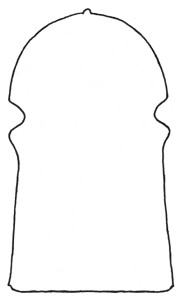
Style 1 |
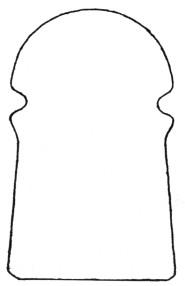
Style 2 |
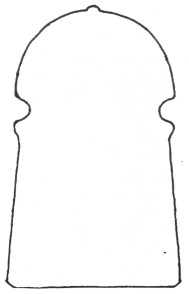
Style 3 |
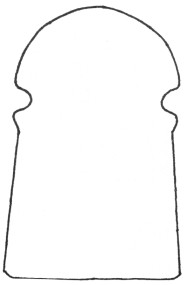
Style 4 |
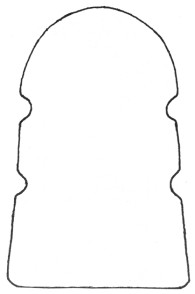
Style 5 |
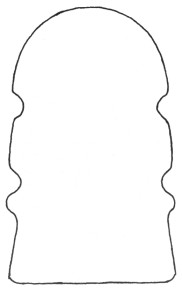
Style 6 |
The CALIFORNIA embossed C.D. 102's that I have listed are styles 1 and 2. Style
2 is most common and can easily be found on sales tables here on the West Coast
for ten to twelve dollars. Style 1 is not usually any more expensive, because no
one takes the time to notice the differences between the two, but it is a little
scarcer. Style 1 is a bit taller than Style 2, being about 3-1/2 inches tall,
while the style 2 is 3-3/8 inches tall. All CALIFORNIA embossed C.D. 102 ponies
that I have ever seen would fall under the "BLUE" category. CALIFORNIA
embossed 102's are very similar to their C.G.I. Co. counterparts. Their main
difference is that the CALIFORNIAS are more slender.
Styles 1 and 3 are
basically the same, as are styles 2 and 4. I refer to 1 and 3 as the "point
top" version of each embossing style, and to 2 and 4 as the "round
top" version. The "point top" has a small button on the very top
of the dome, and the dome is noticeably more pointed than the "round
top" version. The "point top" is fairly common with the C.G.I.
Co. embossing, but I have just recently discovered the CALIFORNIA in this style.
In both versions, the skirt section of the C.G.I. Co. is wider than the
CALIFORNIA.
When standing side by side, the C.G.I. Co.'s have an obviously
heftier look to them due to this wider section. With the "round tops"
the C.G.I. Co. has a skirt diameter at the base of close to 2-1/4 inches, while
the CALIFORNIA has only a 2-1/8 inch diameter at the base. The "point
tops" have an equal size ratio.
I have or have seen the style 3 "point
top" in light sage green, yellow, clear, and smoke-purple. The style 4
"round top" I have in all the colors I know of, which are: (bluish)
aqua, plain green, smoke, and smoke-purple. I have yet to see either style in a
solid dark purple, as you can commonly find the C.D. 161 or 162 signals, but I
believe they exist. C.G.I. Co. ponies generally sell for $4-$6 in all colors
except yellow. I paid $2 for mine, but that was a heck of a deal. The only other
one that I have seen sell had a price tag of $25 on it. That, I would say, is a
fair price for this item.
So far, there are only two styles of "double
groove" pony embossed CALIFORNIA known. One is the "straight
side" version (style 5), and the other is the "keg" (style 6). I
have seen well over 100 of these "straight sides", and I have yet to come
up with a consistent color for them; however, smoke, in one shade or another, is
most common. They range from a light bubbly green to a nice rich purple. The
colors that I have never seen are: blue, aqua, any darker green, or yellow.
These "straight sides" value right around $10 in these parts, but I
have paid as much as $15 for a deep, rich purple one, and as little as $4 for a
near clear one.
All of the "straight sides" that I have ever laid eyes
on had the sharpest, boldest, most pronounced embossing on them. Never a weak or
smeared embossing. This seems to be a trait with these. The only other
"CAL" I have seen with consistently bold embossing on it like on the
"straight sides" is the bottom half of the two-piece tramp. I will get
back to the tramps later.
The "keg" is a real goodie. Every one that I
have seen is BLUE, and most are a brilliant pool-blue. I have seen four sell to
date, and all took between 40 and 50 dollars. Those who got them were lucky, as
they rarely hit the sales table. I am still looking for one of these for my own
collection. I always get there too late. Oh well, maybe next time.
I haven't
noticed any variety amongst these guys, but I have not seen a whole lot of them,
either. They closely resemble the "round top" CALIFORNIA embossed 102,
so maybe there is a "point top" version of this one, too?
|
